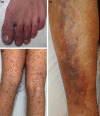Cutaneous manifestations of SARS-CoV-2 infection: a clinical update
- PMID: 32585074
- PMCID: PMC7362144
- DOI: 10.1111/jdv.16774
Cutaneous manifestations of SARS-CoV-2 infection: a clinical update
Abstract
On 11 March 2020, the World Health Organization (WHO) has declared the novel coronavirus disease (COVID-19) a global pandemic, caused by the severe acute respiratory syndrome coronavirus 2 (SARS-CoV-2 virus). A consistent number of case reports and clinical series have been already published describing a complex spectrum of skin manifestations associated with the SARS-CoV-2 infection. We carried out a review of the English-language literature up to 20 May 2020, reporting original cases or case series of the cutaneous manifestations of SARS-CoV-2 virus infection. The following databases were consulted: PubMed, Embase, Google Scholar and ResearchGate. The search of papers was conducted by using the key term 'COVID-19' or 'SARS-CoV-2' or 'coronavirus' combined with each of the following: 'skin', 'cutaneous', 'dermatologic' or 'dermatology', 'manifestation', 'lesions', or 'rash'. The patterns of dermatological manifestations associated with SARS-CoV-2 infection could be classified into four categories: exanthema (varicella-like, papulo-vesicular and morbilliform rash), vascular (chilblain-like, purpuric/petechial and livedoid lesions), urticarial and acro-papular eruption. Lastly, other skin manifestations to be considered are the cutaneous adverse reactions to the drugs prescribed for the treatment of COVID-19. Whether SARS-CoV-2 infection can directly cause a worsening of chronic inflammatory diseases such as psoriasis or atopic dermatitis remains to be determined. Dermatology's outlook in the COVID-19 pandemic is multidimensional.
© 2020 European Academy of Dermatology and Venereology.
Figures


References
Publication types
MeSH terms
LinkOut - more resources
Full Text Sources
Medical
Miscellaneous

